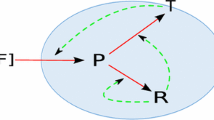Abstract
The phasing technique is a method for synchronizing cell populations in a bioreactor. Periodic changes of substrate supply and depletion can provoke a cell cycle phasing of originally stochastic scattered proliferation patterns. Synchronized cell populations characterized by changes in DNA content distribution can be monitored by flow cytometry. Thus, studies of the dynamics of single cells in specific cell cycle phases are facilitated. Here we present an age structured model framework investigating synchronized populations using delay differential equations. Applying the framework not only cell populations synchronously increasing under balanced growth conditions, but also synchronized cultures growing in continuous phasing experiments can be described. A process model developed for describing phased cultures was fitted to growth data obtained from a synchronous cultivation of Cupriavidus necator. Its potential utility is demonstrated by a quantitative process description and by its ability to identify ways in which the grade of synchrony could be improved.







Similar content being viewed by others
Abbreviations
- B(t),C(t),D(t):
-
concentration of cells in the respective cell cycle phases (cells/l)
- k :
-
constant transition rate (h−1)
- k ph (s):
-
phase transition rate of the process model (h−1)
- k max :
-
maximal transition rate (h−1)
- K s :
-
half-saturation constant of μ(s) (g/l)
- K T :
-
half-saturation constant of k ph (s) (g/l)
- n c :
-
number of executed phase cycles
- N(t):
-
summed concentration of cells in all cell cycle phases (cells/l)
- ps :
-
proportion of synchronization
- R(t):
-
normalized cell division rate (h−1)
- s(t):
-
substrate concentration (g/l)
- T :
-
length of phase cycles (h)
- t d :
-
doubling time (h)
- t i :
-
time of volume exchange (h)
- Y N/s :
-
yield coefficient (cells/g)
- α:
-
volume exchange factor
- δ(t):
-
Dirac delta function
- φ(t):
-
history function of state variables (cells/l)
- μ(s):
-
growth rate (h−1)
- μmax :
-
maximal growth rate (h−1)
- τ ph :
-
fixed phase duration (h)
References
Cooper S, Shedde K (2003) Microarray analysis of gene expression during the cell cycle. Cell Chromosome 2:1–12
Zeuthen E (1964) Synchrony in cell division and growth. Wiley, New York
Walker GW (1999) Synchronization of yeast cell populations. Methods Cell Sci 21:87–93
Cutler RG, Evans JE (1966) Synchronization of bacteria by a stationary-phase method. J Bacteriol 91:469–476
Dawson PSS (1972) Continuously synchronised growth. J Appl Chem Biotechnol 22:79–103
Sheppard JD, Dawson PSS (1999) Cell synchrony and periodic behaviour in yeast populations. Can J Chem Eng 77:893–903
Agar DW, Bailey JE (1982) Cell cycle operation during batch growth of fission yeast populations. Cytometry 3:123–128
Fritsch M, Starruß J, Loesche A, Mueller S, Bley T (2005) Cell cycle synchronization of cupriavidus necator by continuous phasing measured via flow cytometry. Biotechnol Bioeng 92:635–642
Fredrickson AG, Ramkrishna D, Tsuchiya HM (1967) Statistics and dynamics of procaryotic cell populations. Math Biosci 1
Nishimura Y, Bailey JE (1980) On the dynamics of Cooper–Helmstetter–Donachie procaryotic populations. Math Biosci 51:305–328
Fredrickson AG, Mantzaris NV (2002) A new set of population balance equations for microbial and cell cultures. Chem Eng Sci 57:2265–2278
Gurney WSC, Nisbet RM (1983) The systematic formulation of delay-differential models of age or size structured populations. Lect Notes Biomath 52:163–172
Smith JA, Martin L (1973) Do cells cycle? Proc Natl Acad Sci 70:1263–1267
Koch AL (1999) The re-incarnation, re-interpretation and re-demise of the transition probability model. J Biotechnol 71:143–156
Bley T (1987) State-structure models of microbial growth. Acta Biotechnol 7:173–177
Bley T 1992 Delay-differential equations for modeling synchrony and periodic phenomena in microbial population dynamics. In: Karim MN, Stephanopoulos G (eds) Modeling and control of biotechnical processes. Pergamon, New York, pp 195–199
Swat M, Kel A, Herzel H (2004) Bifurcation analysis of the regulatory modules of the mammalian G1/S transition. Bioinformatics 20:1–6
Srienc F (1999) Cytometric data as the basis for rigorous models of cell population dynamics. J Biotechnol 71:233–238
Shampine LF, Thompson S (2001) Solving DDEs in Matlab. Appl Num Math 37:441–458
Cooper S (1979) A unifying model for the G1 period in prokaryotes and eukaryotes. Nature 280:17–19
Müller S (2007) Modes of cytometric bacterial DNA pattern: a tool for pursuing growth. Cell Prolif 40:621–639
Donachie WD (1968) Relationship between cell size and time of initiation of DNA replication. Nature 219:1077–1079
Tyson JJ (1987) Size control of cell division. J Theor Biol 126:381–391
Engelberg J (1961) A method of measuring the degree of synchronisation of cell populations. Exp Cell Res 23:218–227
Nyarko EK, Scitovski R (2004) Solving the parameter identification problem of mathematical models using genetic algorithms. Appl Math Comput 153:651–658
Weber J, Bühner J, Bley T, Göhde R (2006) Populationen überwachen. Durchflusszytometrisches Online-Monitoring zur Prozesssteuerung. BioTec 5–6:32–33
Author information
Authors and Affiliations
Corresponding author
Rights and permissions
About this article
Cite this article
Noack, S., Klöden, W. & Bley, T. Modeling synchronous growth of bacterial populations in phased cultivation. Bioprocess Biosyst Eng 31, 435–443 (2008). https://doi.org/10.1007/s00449-007-0180-6
Received:
Accepted:
Published:
Issue Date:
DOI: https://doi.org/10.1007/s00449-007-0180-6




